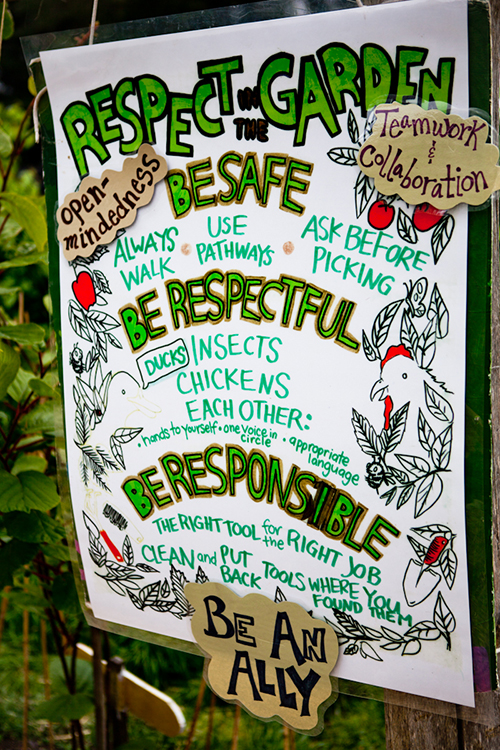
After this lesson, students will be able to:
- Explain the behavioral expectations in the garden using information on the 4BEs poster as a guide
- Demonstrate an increased understanding of the Edible Schoolyard tools, techniques and concepts
- Explain the concepts of compost, harvest, cultivation and propagation
- Discuss in detail events and phenomena that regularly occur in the garden ecosystem
During this lesson, students will:
- Review the behavioral expectations in the garden using the 4BEs poster
- Discuss how teamwork, unity and confidence can be developed in the garden
- Partake in garden work that focuses on compost, harvest, cultivation or propagation
- Use observation and awareness to explore, investigate and be inquisitive learners in the garden
- Garden tools necessary for jobs
- Respect in the Garden visual aid
AT THE OPENING CIRCLE
- Welcome students to the Ramada and introduce the Job Board. Usually, there are 4 jobs, or 4 jobs and one lab, or 1 to 3 stations for students to rotate between.
- Have each teacher explain further about the job they will be leading.
- Introduce the Closing Circle activity so that students are prepared upon returning to circle.
- Review the Respect in the Garden poster with students.
- Divide the class into 4 groups for garden jobs.
IN THE FIELD
- Class is broken into 4 groups, each with one garden teacher and 6-8 students who focus on 1 job.
- Check in and review garden job at job site.
- Have each student answer a “check-in” question.
- Check-in questions should be provocative and fun and may not have anything to do with gardening.
- These questions can relate to the lesson or theme of the day.
- Break down the steps for the garden job and have students identify necessary tools before going to tool shed.
- Work together on your garden job.
- Give students short breaks for chicken time and foraging.
CLOSING CIRCLE
- Lead a fun activity that helps sum up the class. Games and tastings are popular.
- For a tasting:
- Have a group of students prepare the tasting during their Garden Work Rotation.
- Servers pass a tray with the tasting around the Ramada at Closing Circle.
- Students each take 1 piece, and must wait until everyone has been served to taste.
- Encourage them to use their other senses to investigate the food until then.
- After tasting, each student shares their name and, in the 7th grade, draw on their five senses to create a simile about the tasting.
- Example: My name is ______ and my apple was sweet like honey.
All lessons at the Edible Schoolyard Berkeley are developed in collaboration with the teachers and staff of the Edible Schoolyard and Martin Luther King, Jr. Middle School.
Learning Cycle and Think-Pair-Share discussion routine © The Regents of the University of California. All materials created by BEETLES™ at The Lawrence Hall of Science.
This lesson follows the BEETLES Project’s Learning Cycle (Invitation-> Exploration -> Concept Invention -> Application -> Reflection) and uses their Discussion Routines(Think-Pair-Share, Whip-Around). All are highlighted * with an asterisk for easy identification. See the documents BEETLES Discussion Routines and BEETLES Learning Cycle included in Resources below for more information.




